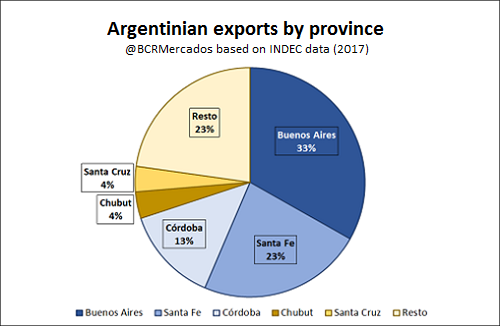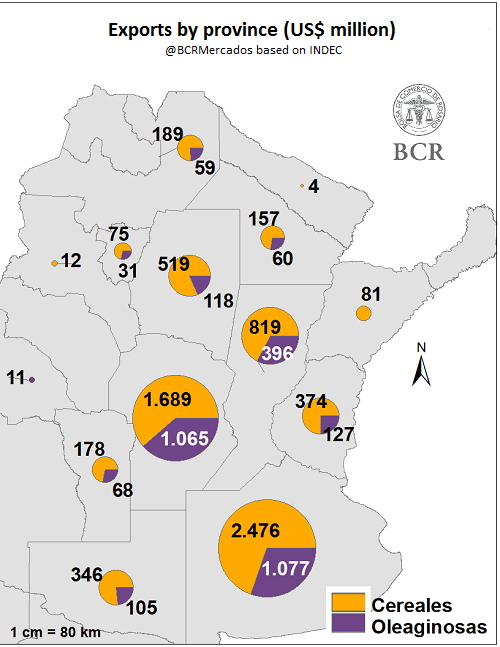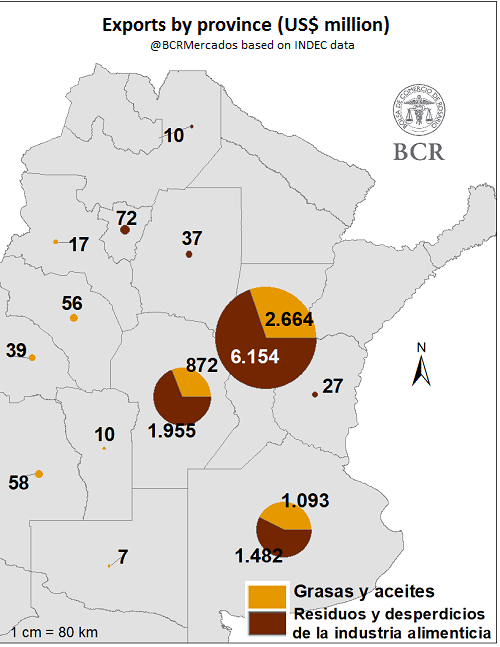Santa Fe province strongly increases its share of total Argentine exports
SOFÍA CORINA - EMILCE TERRÉ
During the two decades period (1997-2017) the Argentine exporting matrix went through a remarkable revolution. The total value of our shipments abroad increased by no less than 120%, measured in millions of dollars. In fact, in 1997 exports generated US$ 26.5 billion while in 2017 there was a foreign currency income from exports of US$ 58.5 billion. The sectors that increased their relevance in terms of international shipments the most are food industry by-products (among them soymeal exports) and oilseed. This was only possible due to the massive expansion of soybean cultivation areas along with the growth of the crushing industry. In 1997, around 11 million tons were exported (beans, pellets and soybean oils) while in 2017 this value rose by 315% exceeding the 45.5 MT. Regarding the local origin of Argentine exports, Buenos Aires province has traditionally lead the ranking although its weight in the total volume of exports has been decreasing over time. In 1997, almost 40% of the nation's exports originated there, while in 2017 that share fell to 33%. On the other hand, the provinces of Córdoba and Santa Fe were the ones that saw their share increase the most. Córdoba went from a 10% to a 13% share in the last 20 years, and Santa Fe from 16% to 23%. Therefore, Santa Fe is the province that increased its weight the most, originating almost a quarter Argentine foreign currency annual income. Currently, Buenos Aires, Santa Fe and Córdoba produce 70% of the total national exports, as shown in the attached graph for the year 2017.
The growing importance of Santa Fe province in Argentine exports is strongly linked to the blooming of the oilseed crushing industry, which is mainly focused on the external market. In 1997, the theoretical crushing capacity in Santa Fe did not reach 52,000 tons every 24 hours, while two decades later, more than three times that volume, 157,000 tons, were processed daily. Hand in hand, the industry's share in the total exports originated in the province went from 12% in 1997 to 45% in 2017 (in other words, from 1.6 to 6. billion dollars). Also, fats and oils shipments went from 7% in 1997 (almost US$ 1 billion exports) to 20% in 2017 (US$ 2.7 billion exports). On the other hand, exports of oleaginous seeds and fruits represent today 3% (US$ 400 million) of the total exports originated by Santa Fe, while cereal shipments are of US$ 800 million, representing a 6% of the provincial total. Consequentially, the exports of cereals, oilseeds and their main by-products are almost 75% of the provincial foreign trade. If we compare the current value of the sector's exports by Santa Fe with the amount of foreign currency that contributed 20 years ago, cereals has increased in a 85%, as seeds and oilseeds rise was of 585%. Food industry by-products exports grew by 285%, and those involving fats and oils by 170%. Regarding the origin of cereal and oilseeds exports, as shown in the map, Buenos Aires has the highest national share, followed by Córdoba and Santa Fe. Buenos Aires production contributes in over US$ 3.5 billion exports, while Córdoba contributes in more than US$ 2.7 billion and Santa Fe another US$ 1.2 billion, of a total revenue in concept of cereals and oilseeds exports of US$ 10 billion.
If we now consider food industry by-products, fats and oils exports by province, the importance of the three territories change. Santa Fe is leads international shipments with a contribution of almost US$ 9 billion over a country-level total of US $ 14.5 billion. Córdoba is in the second place with US$ 2.8 billion and Buenos Aires remains in third place generating US$ 2.5 billion. In line with the aim to generate greater value added, Argentinean by-products exports in 2017 were 45% higher than cereals and oilseeds exports.


